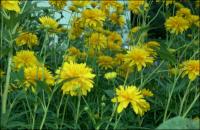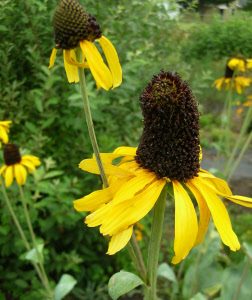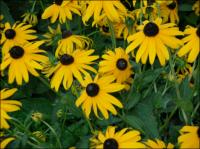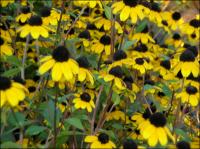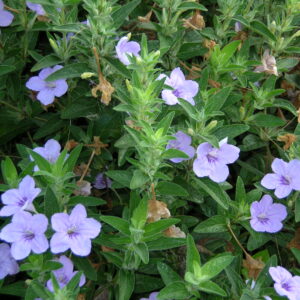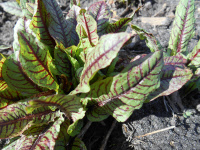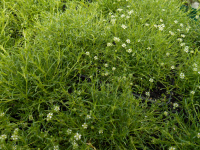Shop
Showing 625–632 of 788 results
-
Rudbeckia laciniata var. hortensia Golden Glow Z 3-9
Imposing double daisies with multiple petals bloom atop a 6 or 7 foot erect stem as thick as a small tree trunk reign over neighboring flowers like a king. “Rich, yellow double flowers borne in autumn, excellent for cutting, “Sanders 1913. Blooms July-August.
Imposing double daisies with multiple petals bloom atop a 6 or 7 foot erect stem as thick as a small tree trunk reign over neighboring flowers like a king. “Rich, yellow double flowers borne in autumn, excellent for cutting, “Sanders 1913. Blooms July-August.
Size: 5-7' x 12" and spreading
Care: sun in moist well-drained to well drained soil, drought tolerant
Wildlife Value: Immune to Walnut toxinsSerendipitous discovery in a group of seedlings in 1894. Said to be “the most popular hardy perennial introduced during the last 25 years,” April, 1905, The Garden magazine. Recommended by Gertrude Jekyll in 1908. Beth in New Mexico advised that her alpaca named Ricardo finds them delicious.
-
Rudbeckia maxima Great coneflower Z 4-9
Magnificent wildflower with huge paddle-shaped leaves of blue-grey-green and tall stalks of finch-gold petals
Magnificent wildflower with huge paddle-shaped leaves of blue-grey-green and tall stalks of finch-gold petals encircling central cones 4-5″ tall.
Size: 5-6' x 2'
Care: Sun in moist to moist well-drained soil
Native: OK, AK, TX & LA
Wildlife Value: Nectar source for larvae of painted Lady butterfly & for large Wood nymph butterfly.Rudbeckia was named by Linnaeus for his University of Upsala professor, Olaf Rudbeck. Rudbeck made the surprising claim “that the Paradise of Scripture was situated somewhere in Sweden.” C.F. Leyel. This species collected by Englishman Thomas Nuttall (1786-1859) in Oklahoma Territory near the Red River in 1816. Nuttall searched much of the No. American continent from New England west to Oregon, the South, Midwest, the Plains, S.E., California & Hawaii, finding thousands of new plants.
-
Rudbeckia subtomentosa ‘Henry Eilers’ Z 4-8
These Rudbeckias tower above basal leaves on rigid, branching stems forming clumps of sun yellow petaled flowers surrounding a raised, brown dome of disc flowers. But instead of flat petals, the petals are rolled into narrow tubes, looking like many spokes of a wheel blooming from mid-summer into fall.
OUT OF STOCK
These Rudbeckias tower above basal leaves on rigid, branching stems forming clumps of sun yellow petaled flowers surrounding a raised, brown dome of disc flowers. But instead of flat petals, the petals are rolled into narrow tubes, looking like many spokes of a wheel blooming from mid-summer into fall.
Size: 3-5’ x 1-2’
Care: sun in moist well-drained soil
Wildlife Value: attracts butterflies, deer resistantHenry Eilers discovered this cultivar while scouting a southern Illinois prairie. Here is his story.
Henry Eilers, born in 1934, long-time nurseryman, had introduced selections of different ornamental plants that he found growing at his nursery. But Rudbeckia subtomentosa ‘Henry Eilers’ is different. Henry worked tirelessly for decades to preserve Illinois plants and their diversity. In the early 1980’s while scouting a prairie remnant near Witt in Montgomery County IL he spied a small clump of uncommon Black-eyed susan. Instead of the usual broad, flat petals, this one has narrow, quilled petals. He dug it and replanted it at his nursery where it grew on. It still grows in his wildflower garden. He decided to name it Rudbeckia ‘Montgomery County.’ In the 1990’s Henry took it and other native wildflowers to a native plant sale at the Shaw Arboretum, Missouri Botanic Garden. He and another nurseryman, Larry Lowman exchanged a few plants, one being this Rudbeckia. Several years later he found it for sale in the Plant Delight’s Nursery catalog, renamed Rudbeckia ‘Henry Eilers.’ Over time the plant appeared in gardening magazines and mail order catalogs. It now grows in the entrance planting at the National Botanic Garden in Washington, at the Missouri Botanic Garden and the Brooklyn Botanic Garden. A nurseryman from the Czech Republic told Henry he had been growing it! -
Rudbeckia subtomentosa Sweet coneflower Z 4-8
These Rudbeckias tower above basal leaves on rigid, branching stems forming clumps of sun yellow petaled flowers surrounding a raised, brown-purple dome of disc flowers.
These Rudbeckias tower above basal leaves on rigid, branching stems forming clumps of sun yellow petaled flowers surrounding a raised, brown-purple dome of disc flowers.
Size: 4-5' x 1-2'
Care: Sun to part shade in moist to moist well-drained soil
Native: East US, Wisconsin native.
Wildlife Value: attracts butterflies, deer resistantRudbeckia was named by Linnaeus for his University of Upsala professor, Olaf Rudbeck. Rudbeck made the surprising claim “that the Paradise of Scripture was situated somewhere in Sweden.” C.F. Level. This species described in 1815. May have been collected by English planthunter John Bradbury (1768-1823).
-
Rudbeckia triloba Branched coneflower, Brown eyed susan Z 3-9
Multitudes of stems, each bearing a small sunny daisy with brown centers at its tip for a sun-drenched crowd from July to October, as cheery as they come.
Multitudes of stems, each bearing a small sunny daisy with brown centers at its tip for a sun-drenched crowd from July to October, as cheery as they come.
Size: 3-4' x 2-3'
Care: sun to part shade in moist well-drained to well-drained soil
Native: most of North America, Wisconsin native
Wildlife Value: Numerous bees, some flies, a few wasps and butterflies feed on the nectar and pollen. One bee feeds only on Rudbeckias and Ratibida flowers.
Awards: Georgia Gold Medal winner. England’s Royal Horticultural Society Award of Garden Merit.Rudbeckia was named by Linnaeus for his University of Upsala professor and founder of the Uppsala botanic Garden, and his son, University of Uppsala professor named Olaf Rudbeck. This species collected in Colonial Virginia in 1600’s.
-
Ruellia humilis Prairie petunia Z 3-9
Lilac open-face trumpets late June-October. Slow to emerge in spring so be patient. One of those non-flashy work-horses, a “MUST HAVE” plant of internationally known garden designer Piet Oudolf. Gardens Illustrated 94 (2013)
Lilac open-face trumpets late June-October. Slow to emerge in spring so be patient. One of those non-flashy work-horses, a “MUST HAVE” plant of internationally known garden designer Piet Oudolf. Gardens Illustrated 94 (2013)
Size: 10-12” x 10”
Care: sun in any soil
Native: Midwest south to Florida and Texas, Wisconsin native where it is endangered.
Wildlife Value: Pollinated primarily by long tongue bees who can reach far into the flower’s throat.Ruellia named for French royal herbalist Jean Ruell (1474-1537.) First collected by Thomas Nuttall (1786-1859) C.1810 English plant hunter who found more American plants than anyone else, early 1800’s.
-
Rumex sanguineus ssp. sanguineus Bloody dock Z 5-8
ornamental green foliage embroidered with red veins
ARCHIVED
Note: This is a plant not currently for sale. This is an archive page preserved for informational use.
Grown for its ornamental green foliage embroidered with red veins.
Size: 12" x 12"
Care: sun to shade in moist well-drained soil
Native: uncommon sport of species from Europe, SW Asia & N. Africa
Size: Containers, borders for bold effect. Young leaves of this Sorrel edible – taste like Chard. Adds color to salads & makes fine soup.Sanguineus means “blood-red”, from Latin sanguis, meaning “blood.” In gardens by 1760’s.
-
Sagina subulata Pearlwort, Irish moss Z 4-7
Tiny white flowers in summer on extra-miniature grass-like leaves
OUT OF STOCK
Tiniest of white flowers in summer on mound of extra-miniature grass-like leaves.
Size: ½” x 8”
Care: sun to part shade in moist well-drained soil
Native: CorsicaSagina subulata was discussed in Revue Horticole in 1896. The variety aurea extensively used for carpet bedding. H.H. Thomas, 1915. Perfect for rock gardens, between stepping stones on a path or as a groundcover.

